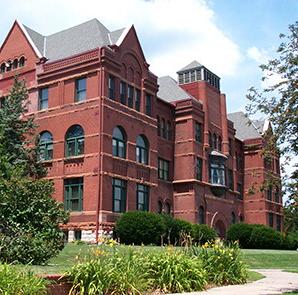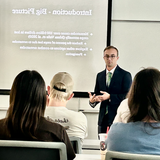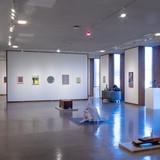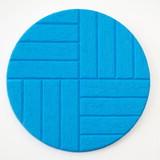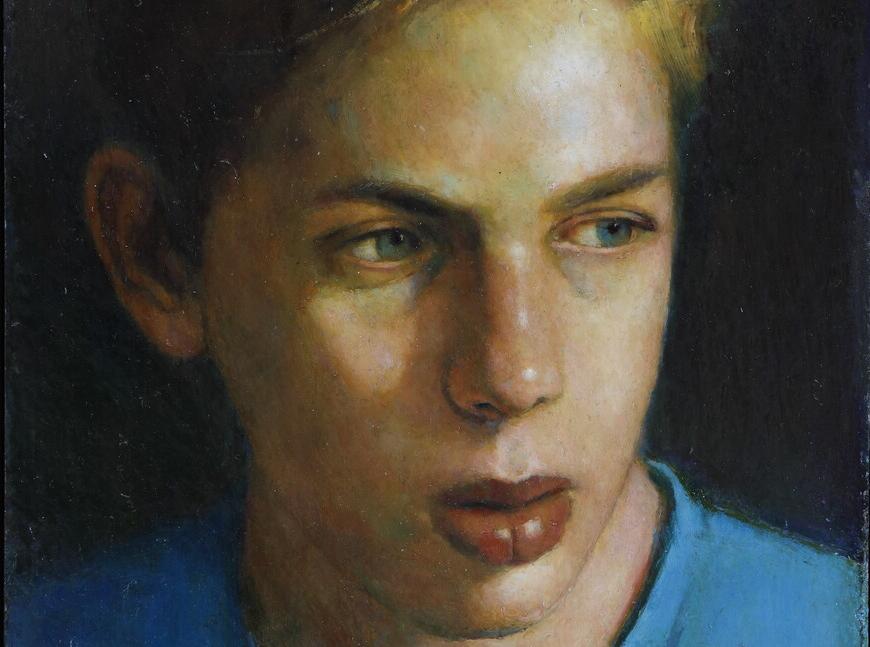已故现实主义艺术家斯蒂芬·布朗(斯蒂芬。 Brown)的作品将于本月晚些时候在NWU的大画廊展出. The exhibit is entitled The Aching Beauty of it All: Paintings by 斯蒂芬。 Brown. 这将是这位艺术家的作品首次在内布拉斯加州展出.
这次展览展出了这位已故艺术家生涯中的70多幅画作. 布朗出生于科罗拉多州的格里利,在纽约市和新英格兰度过了他的职业生涯. 他获得了美国艺术与文学学院颁发的奥斯卡绘画奖, The Gladys Emerson Cook Prize from The National Academy of Design, 以及本杰明·奥特曼奖(Benjamin Altman Prize),该奖由美国国家设计学院的一名美国公民设计. 布朗是许多个人博物馆和画廊展览的主题.
The exhibit 是 curated by Associate Professor of Art 大卫·格雷西 who 是 Brown’s student at the Hartford Art School. Gracie also produced a catalogue and essay for the occasion. 展览将于11月9日开幕,并于11月12日下午5点至7点举行招待会.m. 位于第50街和亨廷顿大道的罗杰斯美术中心内的埃尔德画廊. Gallery hours are Tuesday-Friday from 10 a.m. 到下午4点.m. and Saturday-Sunday from 1-4 p.m. The gallery will be open by appointment only during Thanksgiving and winter breaks. To schedule an appointment, contact David Gracie (dgracie [at] chicksthatlift.net (dgracie[at]nebrwesleyan[dot]edu)).
The Aching Beauty of it All: Paintings by 斯蒂芬。 Brown, an essay by Associate Professor of Art David Gracie
上世纪90年代末,哈特福德艺术学院绘画构图课的第一天,我紧张地等待着教授的到来. 一只脚踏出门外,斯蒂芬·布朗教授出现了,他挥舞着双臂指引我们出去. The weather 是 beautiful out. The edge of late summer heading 成 a 新英格兰秋季. 史蒂芬的指示是用树枝、树叶、橡子组成一幅画, 或者其他 在撒谎 about on the grass and ground near the art building. 我不明白斯蒂芬在热情地谈论运动时在说些什么, balance and the framing edge, 但我 去了 工作 regardless and in earnest. I 可以 still picture the look in his eyes. 我仍能听见 the excitement in his voice. 当斯蒂芬 参观了 我的那块草坪 he adjusted a stick a quarter inch, 提高了 的板块r,扔 还有一个. He stepped closer in and 然后 回来. 斯蒂芬。 是 seeing the world as a painter.
斯蒂芬。 Brown walked a line between art and life. Painting is how he took in the world and marked time. 他的目标是在绘画的框架边缘内调和生活的痛苦之美. Painting 是 斯蒂芬。’s affirmation of being alive.
斯蒂芬想立即宣布油画颜料有时粗糙,有时非凡的可塑性,同时对他所生活的风景怀有敬意, the people he loved, the bric-a-brac that surrounded him. 这种摩擦 媒介/科目 / 艺术/生活 可以, at special moments, create transcendence. 作为他的学生,斯蒂芬经常把这些超越的时刻称为“魔法”.他告诉我,你永远无法预测这种“魔力”何时会发生,直到它到来. It would hit you like an epiphany.
When making his small 绘画 斯蒂芬。 would often work with the painting in his lap. He described this as “almost being on 顶部或 在它里面.“这幅画的朝向很清楚,它既是一个物体,也是一个图像. While holding the painting in his lap, 他会用珠宝商的放大镜来窥探表面的深处. 他会建造不透明的通道,涂上透明的颜色,然后涂上半透明的颜料s 在上面. 他总是小心翼翼地不落入一个系统,他会磨磨蹭蹭地去 揭示 段落 成 早些时候,层. The subtractive element allowed earlier moments of the painting’s self-narrative to come to the surface alongside newer marks. 就像驾驭波浪一样,斯蒂芬用直觉和技巧作画,每一步都汇入下一步. With each seeming final decision 的板块r problem 是 presented. At a certain point, on the crest of the wave, 他在画的那一刻,这幅画的沉闷被世界的活力激发了生命.
斯蒂芬在他的脑海中只画了一张粗略的蓝图. He would build them up and 然后 tear them down. He would scrape, sand, cut, glue, glaze and repeat. 这 过程 是 not a straight line. He 是 coaxing something out of 以太. 斯蒂芬明白参与绘画史的重要性和特权. 在课堂上,他回忆起他的导师兼朋友爱丽丝·尼尔(Alice Neel)是如何只真正喜欢一位艺术家的——弗朗西斯科·戈雅. 我认为尼尔的狭隘促使斯蒂芬对各种各样的工作方式持开放态度, 而“开放”反过来又让斯蒂芬总是在自己的画作中寻找.
当我开始 17 在内布拉斯加州卫斯理大学任教的一年里,我可以反思我的每一个学生是如何 is taught 斯蒂芬。’s way of seeing the world as a painter. 就像我在康涅狄格州哈特福德的一个秋天第一次看到的那样.
斯蒂芬, the possibility of the image in his 绘画 是 always in flux to the very end. 他会把干燥的颜料粘在绘画表面,并将它们融入现有的表面. He would often find the framing edges well 成 the painting 过程 and redefine them with tape and a table saw. 在课堂上,他描述了在他的画的顶部粘上一条木条的过程 提供更多的 空气和 space, to let the work 呼吸. The active surface, full of different levels of resolution all at once, is an analogy for the world moving underneath our feet.
With his 过程 being additive and subtractive, concealing and 揭示ing, the 绘画 have a complicated relationship to time. Many different marks, 段落 and edits, are different moments in the making. 你会看到一个手势刷标记从早期的过程中,旁边的宝石通道 有 been scraped with a razor blade. Like a person standing in front of you, an object on the counter, or a landscape captured by your gaze, you sense the history leading up to the point in time when you are 现在 beholding his 绘画. 那段历史的细节和顺序并不清楚,但你确信它的存在.
在斯蒂芬的绘画中,色彩可以同时表现出自己的优点, 同时, be seamlessly integrated 成 the full image. 他明白,作为一名现实主义画家并不仅仅意味着你要复制你之前的东西. 油漆颜色 i特立独行的 同样真实,有自己的材料,概念和表达潜力. Much 有 been written about the light in 斯蒂芬。’s work. I view 斯蒂芬。’s use of light as architectural supports; the genius of the work is his use of color. 很多次在课堂上,斯蒂芬会走到我的画架前说:“把这个颜色画得更好.他并不是说我所混合的颜色与我在课堂上看到的静物画的颜色不完全匹配, he meant that I should keep searching for the 非凡的.
对斯蒂芬来说,他自己辛苦而痴迷的绘画过程可能会让他筋疲力尽. 他了解到,如果他“把所有的鸡蛋放在一个篮子里”,就会付出感情上的代价. Through experience, 斯蒂芬发明了一种工作方式,他可以同时画很多幅画. He would set an egg timer and paint for a frenzied period of time. At the chime he would switch 绘画 and reset the timer. 这, 他说, 让他专注于最重要的事情:能让他最快乐的部分. 现在回想起来,我相信这个过程不仅仅是为了打破强迫倾向. The 过程 allowed more of the life he loved 成 the studio. With the painting in his lap, peering 成 the surface, 他把他的整个历史和他的爱都写在他的笔尖上.
当我开始 17 在内布拉斯加州卫斯理大学任教的一年里,我可以反思我的每一个学生是如何 is taught 斯蒂芬。’s way of seeing the world as a painter. 就像我在康涅狄格州哈特福德的一个秋天第一次看到的那样. 我以前的许多学生都计划回校园看斯蒂芬斯的演出. 然后继续.
这 exhibition 有 been made possible by the work, wisdom, and generosity of Gretchen Treitz-Martin. 我是 并且将会是 永远心存感激.
大卫·格雷西 Associate Professor of Art
Nebraska Wesleyan University | 2021

